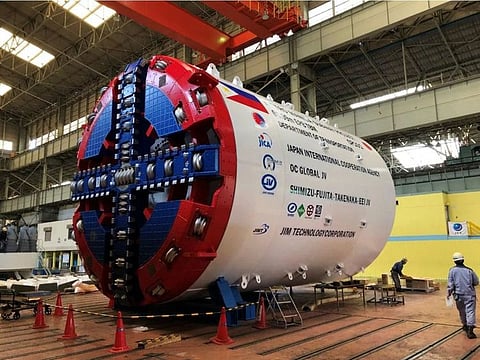19 tunnel boring machines for Manila subway set
33-km Metro Manila Subway Project gets boost with more tunnel boring machines

Manila: Up to 19 of tunnel boring machines (TBMs), each weighing 600 tonnes, will be used for the under-construction Manila subway project, according to the Department of Transportation (DoTr).
The agency announced the addition of two more tunnel boring machines (TBMs) to the Metro Manila Subway Project (MMSP), bringing the current total to six.
This significant increase in equipment aims to expedite construction of the $8.33-billion subway system.
“We already have four TBMs operating almost 24 hours a day,” DOTr Secretary Jaime Bautista told local media. “Within the year, that number will become six.”
The project is divided into several contract packages, concurrently being executed. Bautista highlighted plans to further boost the tunnel borers for MMSP to "at least 19" during the height of tunneling works.
Manila is building the country's first-ever underground railway system. Station excavation started in Q4 2021. The first TBM started working in Q2 2022.
Manila residents, with only three operational light railway lines, suffer from horrendous traffic mess. Two new rail lines (58.8 km) are under construction and scheduled to open in 2025, while five more lines are currently in the approval-planning stage.
According to DOTr data, an estimated 1.2 million cubic meters of soil – equivalent to 500 Olympic-sized swimming pools – needs to be excavated for the initial operational section of the project.
An 711,000 cubic meters (equivalent to 285 Olympic-sized swimming pools) will be dedicated to tunnel construction alone.
33 km, 17 stations
While TBMs tackle the underground sections, the DOTr is also working closely with contractors to expedite the construction of the 17 stations that will be part of the subway project.
Upon completion, the 33-kilometer subway line will connect Valenzuela City in the north of Metro Manila to FTI-Bicutan in Parañaque City – it will have a “spur” line reaching Ninoy Aquino International Airport (NAIA) Terminal 3 in Pasay City.
Benefits
This underground railway system promises to significantly reduce travel time between Quezon City and NAIA, from the current average of 70 minutes to just 35 minutes.
The first cutter head of the first tunnel boring machine (TBM), named “Kaunlaran" (Progress), arrived in February 2021. The cutter head, weighing about 74-tonnes, is the largest part of a TBM and is designed to break, cut, and grind rocks and soil using its rotating 36-piece disc cutter.
Operational light rail lines in Manila:
LRT-1 (Green Line): North-south direction, 17.2 km, 20 stations (including extension). MRT-2 (Blue Line): East-west direction, 13.8 km, 11 stations. MRT-3 (Yellow Line): North to south (along EDSA), 16.9 km, 13 stations.
Infrastructure bottleneck
The economic region of Manila (Mega Manila Urban Region), has an estimated population of 26.4 million people, encompasses the surrounding provinces to the northeast and south, according to an Asia Pacific Economic Cooperation document.
Metro Manila is growing rapidly, which presents a strong economic opportunity. However, underinvestment in modern transportation infrastructure is hindering this economic growth.
MMSP Tunneling Fact File
Volume: 5 million cubic meters of soil to be excavated (equivalent to 2,500 Olympic-sized swimming pools). Length: 36 kilometers Stations: 15 stations (Quirino Highway, Quezon City to NAIA Terminal 3, Pasay City and FTI, Taguig City) Localities traversed: 7 Operations: Initial run in 2025, full operations in 2029 Passenger capacity: Initial full-year operations: 370,000 passengers/day Design capacity: 1.5 million passengers/day
Sign up for the Daily Briefing
Get the latest news and updates straight to your inbox



